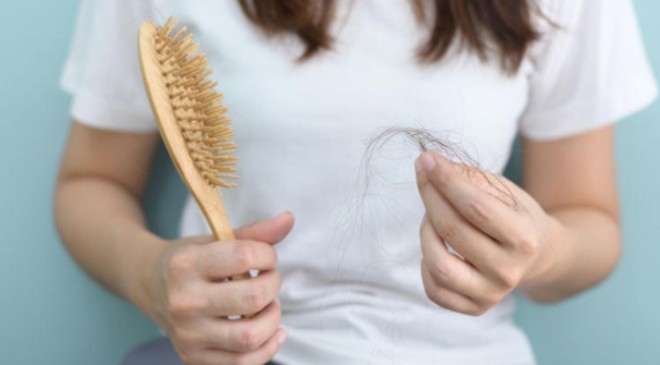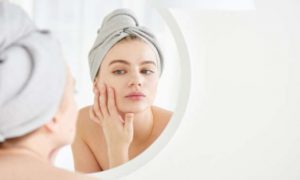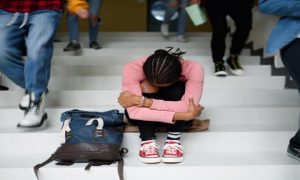- A new study found over 52% of women over 50 years old experience hair loss.
- The research also found 60% of participants who experienced hair loss also reported having low self-esteem.
- Experts say this hair loss is likely due to the changes in hormones in postmenopausal women—but there are ways to slow it down.
As men age, there’s almost an expectation that they’ll experience thinning hair. In fact, men who are able to maintain their thick manes are often seen as the exception. But a new study found that the majority of women also lose hair as they age, and it’s greatly impacting their self-esteem.
The study published in the journal Menopause found more than half of women over 50 years old will experience thinning hair. Researchers from Thailand evaluated nearly 200 postmenopausal women between the ages of 50 and 65 years old for female pattern hair loss. They noted details about their medical history including time since menopause, levels of scalp sebum (a naturally occurring oily substance), serum testosterone, estradiol (a form of estrogen), thyroid-stimulating hormone, hemoglobin (protein in red blood cells), family history of hair loss, and self-esteem.
What did the study find?
Of the participants, 52.2% experienced female pattern hair loss. Of those women, 73.2% had mild hair loss, 22.6% had moderate hair loss, and 4.3% had severe hair loss. Researchers found older age and higher body mass index were significantly associated with thinning hair. Additionally, the study found that 60% of participants experienced low self-esteem, and this increased with the severity of their hair loss.
Female pattern hair loss is the most common cause of hair loss in women. It’s often identified as a widening part, receding temples, or thinning hair, according to the American Academy of Dermatology Association (AAD). “Female pattern hair loss is the most common cause of hair loss in women where the frontal hairline is maintained, but there is progressive hair thinning at the top of the scalp area,” explains Jessica Shepherd, M.D., board-certified OB-GYN.
Why might menopause spur hair loss?
But women can lose their hair for a variety of factors, explains Glynis Ablon, M.D., F.A.A.D., founder of the Ablon kin Institute and Research Center. Anything from their hormone function, environment, and stress, to their immune system, changes in metabolism, or nutrition can play a role.
When women lose their hair due to female pattern hair loss, this is most often due to genetics, explains Emily Guo, M.D., F.A.A.D., a dermatologist at Dermatology and Laser Surgery Center. But in severe cases, it can be due to hypothyroidism, telogen effluvium, a stress-related shedding of the hair, or a nutrient deficiency like low levels of iron or vitamin D, she adds.
“This study confirms what we have seen clinically in our practice for years, which is that the prevalence of hair loss in postmenopausal women is high, and age is a factor as well, further supporting the need for early detection and expansion of therapeutic options,” Dr. Ablon says.
When women transition through menopause, their estrogen, progesterone, and testosterone drop. But, testosterone drops at a much slower rate, causing an androgen (a group of hormones that play a role in reproductive health) dominance and hair thinning, she says.
“In postmenopausal women, hair loss is typically caused by general aging and hormonal changes. As anyone ages, hair loss and thinning start to become more common,” Dr. Shepherd says. “This is also when estrogen levels start to drop which makes hair grow slower and appear thinner. Lowered levels of estrogen and progesterone also contribute to hair loss as these hormones are what typically make hair grow faster and stay on the head longer.”
And if your hormone changes don’t make an impact, the stress of going through this difficult period of time might. “A woman may experience more stress during this time, as evidenced by elevated levels of the stress hormone cortisol. These hormonal changes and shifts can really challenge the hair follicle, contributing to hair thinning,” Dr. Ablon adds.
Are there treatments for female hair loss?
For those who are experiencing hair loss, Dr. Ablon says you can visit your dermatologist to determine the best treatment option for you. Some expert-recommended solutions include platelet-rich plasma therapy, injectables, low-level light laser therapy, or light-emitting diodes. She adds there are also some off-label medications that impact hormonal factors that may be used and hair transplants are also an option.
There aren’t too many over-the-counter hair loss treatment options on the market. The only FDA-approved product to treat hair loss in women is minoxidil, which is available over-the-counter, Dr. Ablon says. The AAD suggests women use no more than 5% minoxidil to treat female pattern hair loss.
Other over-the-counter options include hair growth supplements, like Viviscal that can be beneficial to hair loss, Dr. Guo says, but be sure to check with your doctor before starting any new supplements. Dr. Ablon particularly recommends Nutrafol, a supplement she has performed research on and published a study on to scientifically back the efficacy and safety. Additionally, Dr. Guo says low-level laser therapy caps can be purchased for at-home use, like Theradome.
If you’re concerned about recent hair loss, it’s best to speak to your healthcare provider to learn more. And luckily, there are plenty of ways to combat thinning hair.
Try 200+ at home workout videos from Men’s Health, Women’s Health, Prevention, and more on All Out Studio free for 14 days!

























